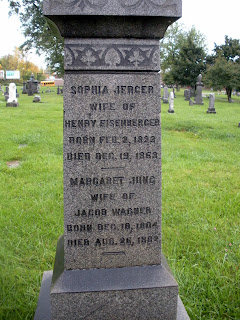During the early 19th century this neighborhood was known for it's German population. The most obvious and enduring legacy of this lies in the names of the streets. As I traveled down the main roads of the area I passed streets with names such as Rohr, Kehr, Kiefer, Roetzer, etc. I'm guessing these street names were derived from the surnames of early settlers since these names show up with some frequency in the genealogy of the neighborhood during the late 19th century (here).
Street signs are not the only place which display the names of another time. Old business buildings from the German era still stand and in many cases were simply abandoned and never reoccupied:
This time faded sign still reads ZIEBART, but it's purpose is not very obvious.
Across the street from this location sits another which was quite revealing of the past: the Concordia Cemetery. Nearly every tombstone here displays a German name.
I also found that many of these tombstones were adorned with what appeared to be a vase draped with some sort of cloth. The picture below shows three gravestones with this feature:
And this next one is a closer view but not as detailed:
I'm not sure if this is a common object to put on tombstones or if it is uniquely German.
A more subtle way the German immigrants and their descendants influenced the landscape of this area was in building and home designs. First, consider this image from a building in a rural area of southern Germany:
Elements of this style were often seen throughout the neighborhood. The most common German features could be seen in the roofing and the heavy lines which appear on the outside walls of the buildings.This is called timber framing in English. In German this style is known as Fachwerkhäuser and is generally associated with farm homes.
There was also this building which looks very European on the top and somewhat tastelessly references the German style on the groundfloor:
As revealed in the reading for this assignment, such self aware references are common. The best example of this in the Lower East Side (and a pretty good example of this phenomenon in general) is the St. Mary of Sorrows church on Genesee street:
This incredible building was completed in 1891 and was designed with the specific purpose of highlighting the areas German heritage. This was accomplished by borrowing heavily from the Romanesque architecture of the Rhineland in Germany. As a result the entire composition of this building can be explained by studying that specific style. Today the building houses the King Center Charter School.
The German occupancy of the lower East Side exists today only through these subtle architectural details.The shift in ethnicity has nearly erased evidence of a previous reality. It barely exists in memory, if at all. While exploring these landmarks I tried as often as possible to ask residents and employees if they could tell me something - anything- about what this neighborhood used to be. The only responses I received were wrinkled foreheads and confusion. Looking at past photographs of the area it's hard to believe that such a vibrant time could ever be forgotten.









Fascinating remnants. That was a great idea to visit the cemetery. Like foodways, deathways seem to hang on to traditions. I wonder about those draped vases. Maybe google image some cemeteries in Germany from the same era, keeping in mind regional/religious variations?
ReplyDelete